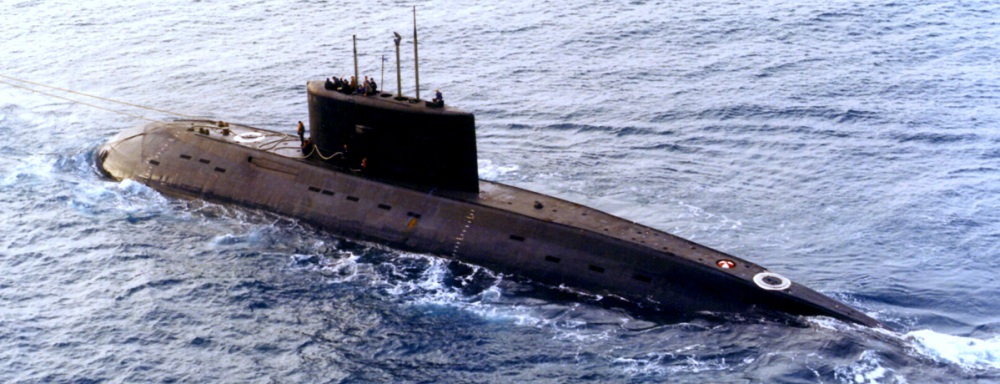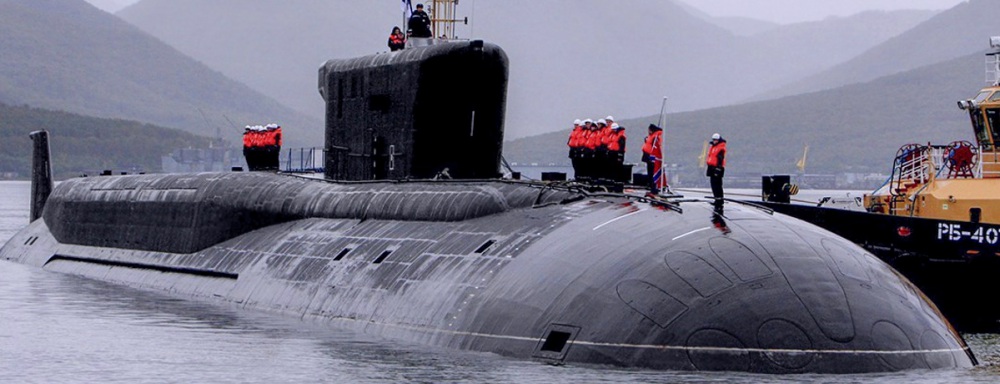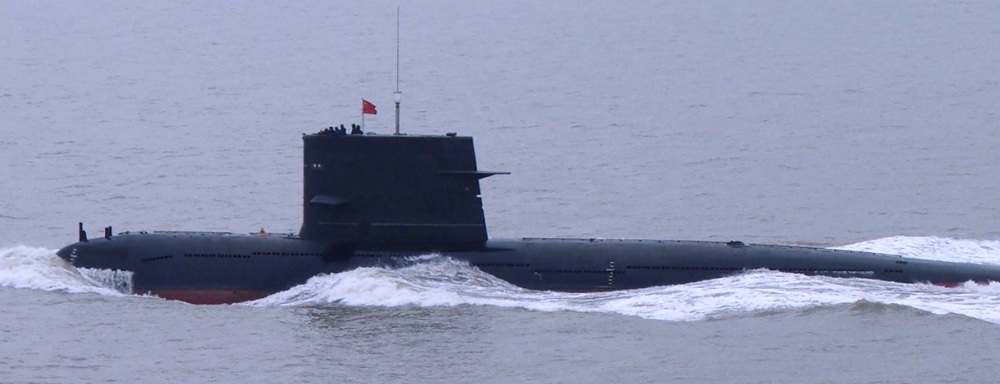
About the image
Capabilities at a Glance
The Islamic Republic of Iran Navy (IRIN) commands a submarine force of 19-27 vessels. The IRIN plays a crucial strategic role in Iran’s national security architecture due to the country’s dependence on the Persian Gulf for trade and security. Besides the Persian Gulf, Iran’s naval forces also operate in the Caspian Sea, the Gulf of Oman, the Arabian Sea, and the Indian Ocean.
Total Submarines in Fleet: 19-271
- Ballistic Missile Submarines (SSBNs): 0
- Nuclear-Powered attack submarines (SSNs): 0
- Diesel-electric attack submarines (SSKs): 4
- Mini Submarines (SSMs): 15-23
- Air-independent propulsion (AIP) enabled: 0
History
The IRIN developed from the shah’s Imperial Iranian Navy, which existed prior to the 1979 revolution and was designed to demonstrate the power and prestige of the shah’s Iran.2 Currently, Rear Admiral Shahram Irani commands the IRIN.3 Iran possesses a second naval force, the Islamic Revolutionary Guard Corps Navy, but the IRIN is currently the sole operator of Iran’s submarine fleet.4
From 1992 to 1996, Iran commissioned three Kilo-class (called Tareq-class in Iran) diesel-electric submarines built in Russia. Iran reportedly paid $600 million USD for each boat. The vessels are all currently based at Bandar Abbas in the Strait of Hormuz, where two of the submarines are operational at any time. These submarines are occasionally deployed in the eastern mouth of the Strait, the Gulf of Oman, and the Arabian Sea.5 Their utility in the Persian Gulf is, however, somewhat limited as Kilo-class boats require a depth of at least 164 feet and can therefore only access about one third of the Gulf.6 Unique water conditions in the Gulf such as water salinity and strong currents further limit the boats’ operational use unless the submarines are deployed to deeper waters in the Gulf of Oman or the Arabian Sea.7
In 2007, Iran began deployments of small Ghadir-class and Nahang-class mini submarines for use in shallow coastal waters. Reports on the number of operating Ghadir-class submarines range from 12 to 22, but in 2019, the U.S. Defense Intelligence Agency estimated that Iran possessed 14 such submarines.8 These vessels possess two 533mm tubes for firing torpedoes or Jask-2 anti-ship cruise missiles (ASCM).9 Iran also reportedly operates one Nahang midget submarine, which became operational in 2007.10
Modernization and Current Capabilities
Iran is actively expanding and modernizing its submarine fleet. Originally, none of Iran’s submarines were capable of firing ballistic or cruise missiles. Starting in the 1990s, Iran launched a program to acquire or domestically produce mines and torpedoes for all its subsurface boats.11 In 2005 it reportedly launched two local production lines of 533mm and 324mm wake-homing torpedoes with ranges of up to 20km.12 Iran has since developed ballistic and cruise missile technology for its submarines. On 24 February 2019, Iran successfully test-fired a cruise missile from one of its Ghadir-class vessels. The Islamic Republic News Agency (IRNA) claims the Tareq and the Fateh submarines have the same capability.13
In June 2012, an Iranian official asserted that scientists were in “the initial phases of manufacturing atomic submarines.”14 Despite delays, Iran claimed its success in retrofitting one of the imported Kilo-class submarines (after Russia had declined to do so) was evidence of the country’s advancing submarine development capability.15 In September 2017, Iran’s naval command said that the country’s nuclear agency was beginning to produce nuclear reactors for fueling and propulsion systems.16 However, many analysts assert that manufacturing a nuclear reactor for submarine use is beyond Iran’s current capabilities and is simply a response to increased U.S. sanctions after the U.S. withdrawal from the JPCOA.17
Iran is also experimenting with submersibles, unmanned vessels, and other submarines. The Sabehat-15 GPS-equipped two-seat submersible swimmer delivery vehicle (SDV)—designed by the Esfahan Underwater Research Center—has undergone testing with both the IRIN and the IRGCN. Due to their limited endurance and payload, SDVs are primarily used for mining, reconnaissance, and special operations in coastal waters.18 In March 2022, the IRGC displayed unmanned underwater vehicles for reconnaissance.19 In the future, the IRGC plans to operate new crewed submarines as well, historically the purview of the IRIN.20
Ship Biographies
Tareq-Class (Kilo-Class)
Iran’s three Tareq-class diesel-electric submarines were built in Russia. These submarines are 74 meters long with a 10 meter beam and can travel up to 17 knots when submerged. They have six 533mm tubes for torpedoes and ASCMs, and they can also lay mines.21 Iran refitted all three submarines in 2012 but has struggled to maintain them in operation since.22
Besat/Qaem-Class
Iran started construction of these semi-heavy, diesel-electric vessels in 2008. According to the Iranian press, these submarines will have a displacement weight of 1300 tons and mount six torpedo tubes. However, as of November 2021, these submarines have yet to enter service.23
Fateh-Class
Iran reportedly has built two Fateh-class diesel-electric coastal submarines, one of which the IRIN officially commissioned on 17 February 2019. It measures 48 meters long and its estimated top speed is between 14 and 23 knots.24 Like the Kilo-class, Fateh has six 533mm tubes for torpedoes and ASCMs and can lay mines.25
Nahang-Class
Iran reportedly possesses one Nahang-class mini-submarines. Iran indigenously built this diesel-electric coastal submarine. Nahang has no torpedo tubes although it may be able to carry mines or torpedoes externally. Its primary mission is likely transporting special operations forces.26
Ghadir-Class
Iran reportedly possesses twenty-three Ghadir-class mini submarines. Iran indigenously built these diesel-electric propulsion submarines capable of firing torpedoes and missiles. The Ghadir-class is also referred to as a sub-class of the Yono-class, suggesting that the submarines may be based on North Korean technology. North Korea may have built he first one or two Iranian Yono-class submarines, but the exact level of North Korean involvement in design and production is unknown.27
Import and Export Behavior
Imports
Iran historically relied upon submarine imports from China, North Korea, and Russia but has been increasing its independent capabilities in recent years. In 1973, Iran founded the Iran Shipbuilding & Offshore Industries Complex Co. (ISOICO) 37 km west of Bandar Abbas, Hormozgan, which has become a major shipbuilder for the country.28 Iran has built and maintained all its submarines domestically since 2005.
Exports
Iran is not an exporter of submarines.
Explore the Collection
Australia Submarine Capabilities
Brazil Submarine Capabilities
Chile Submarine Capabilities
China Submarine Capabilities
France Submarine Capabilities
Germany Submarine Capabilities
Greece Submarine Capabilities
India Submarine Capabilities
Indonesia Submarine Capabilities
Your are currently on
Iran Submarine Capabilities
Israel Submarine Capabilities
Italy Submarine Capabilities
Japan Submarine Capabilities
Malaysia Submarine Capabilities
Netherlands Submarine Capabilities
North Korea Submarine Capabilities
Pakistan Submarine Capabilities
Russia Submarine Capabilities
Singapore Submarine Capabilities
South Korea Submarine Capabilities
Sweden Submarine Capabilities
Taiwan Submarine Capabilities
United States Submarine Capabilities
Submarine Detection and Monitoring: Open-Source Tools and Technologies
Stay Informed
Sign up for our newsletter to get the latest on nuclear and biological threats.
More on

Russia Submarine Capabilities
Overview of Russia's submarine capabilities and import-export behavior.
United States Submarine Capabilities
Overview of the United States' submarine capabilities and import-export behavior.

China Submarine Capabilities
A highlight of global trends in the sale and acquisition of diesel- and nuclear-powered submarines by country with capabilities, imports and exports. (CNS)
Sources
- “Iranian Naval Forces: A Tale of Two Navies,” U.S. Office of Naval Intelligence, 1 March 2017, www.usni.org; “Iran Military Power: Ensuring Regime Survival and Securing Regional Dominance,” Defense Intelligence Agency, August 9, 2019, www.dia.mil; and “Iran Navy Equipment,” Global Security, accessed August 10, 2022, www.globalsecurity.org.
- Lachin Rezaian, “Leader makes new appointments in Iran’s,” Mehr News Agency, 5 November 2017, www.mehrnews.com.
- “New Commander of Iranian Army’s Navy Appointed,” Fars News, August 17, 2021, www.farsnews.ir.
- Jeremy Binnie, “Iran to Operate ‘Semi-Heavy’ Submarines,” Janes, March 23, 2021, www.janes.com.
- Fariborz Haghshenass, “Iran’s Asymmetric Naval Warfare,” (Policy Focus #87, The Washington Institute for Near East Policy, September 2008), p. 17.
- Philip G. Laquinta, “The Emergence of Iranian Sea Power,” Naval War College, 13 February 1998, p. 6.
- Caitlin Talmadge, “Closing Time: Assessing the Iranian Threat to the Strait of Hormuz,” International Security, Vol 33, No. 1 (Summer 2008) p. 90.
- “Iran Builds Submarine Force in Persian Gulf Face-off,” UPI.com, 20 April 2012; “Iranian Naval Forces: A Tale of Two Navies,” U.S. Office of Naval Intelligence, 1 March 2017, www.usni.org; “Iran Military Power: Ensuring Regime Survival and Securing Regional Dominance,” Defense Intelligence Agency, August 9, 2019, www.dia.mil; and “Iran Navy Equipment,” Global Security, accessed August 10, 2022, www.globalsecurity.org.
- H. I. Sutton, “Iran’s Best Submarines Have Been Out of the Water for a Month,” USNI News, January 31, 2021, https://news.usni.org; and “Iran Made Underwater Submarine Launched Cruise Missile (SLCM) Ghadir Submarine,” YouTube video, 3:40, posted by “Persian_boy,” February 24, 2019, www.youtube.com.
- Iran’s Naval Forces: From Guerilla Warfare to a Modern Naval Strategy, (Office of Naval Intelligence, Fall 2009), p. 18; “Iran’s Locally-Built Submarine Becomes Operational,” BBC Monitoring Middle East – Political, 7 March 2007, www.lexisnexis.com.
- Jahangir Arasli, “Obsolete Weapons, Unconventional Tactics, and Martyrdom Zeal: How Iran Would Apply Its Asymmetric Naval Warfare Doctrine in a Future Conflict,” (George C. Marshall European Center for Security Studies, Occasional Paper No. 10, April 2007), p. 22.
- “Iran’s Naval Forces: From Guerilla Warfare to a Modern Naval Strategy,” (Office of Naval Intelligence, Fall 2009), p. 17; “Submarine Forces, Iran,” Janes Underwater Warfare Systems, 5 September 2011, www.janes.com; Fariborz Haghshenass, Iran’s Asymmetric Naval Warfare, (Policy Focus #87, The Washington Institute for Near East Policy, September 2008), p. 14.
- “Iran Test-Fires Cruise Missile from Submarine in Military Drill,” RadioFreeEurope RadioLiberty, 24 February 2019, https://www.rferl.org.
- “Iran Plans to Build Nuclear-Fueled Submarines,” Fars News Agency, 12 June 2012, http://english.farsnews.com; “Iran to Make Engine Systems for Nuclear Submarines,” BBC Monitoring Trans Caucasus Unit, 12 June 2012, www.lexisnexis.com.
- “Iran Plans to Build Nuclear-Fueled Submarines,” Fars News Agency, 12 June 2012, http://english.farsnews.com; Jeremy Binnie, “Iran Relaunches ’Kilo’ Submarine,” Jane’s Defence Weekly, 6 June 2012, www.lexisnexis.com.
- Callum Paton, “Tehran Plans to Build Nuclear Submarines despite U.S. Warnings,” Newsweek, 23 February 2018, www.newsweek.com.
- Frank Von Hippel, “Mitigating the Threat of Nuclear-Weapon Proliferation via Nuclear-Submarine Programs,” Journal for Peace and Nuclear Disarmament 2, no. 1 (2019): 133-50.
- Awad Mustafa, “Gulf Navies Seek Solutions to Iran Midget Sub Threat,” Defense News, last modified 9 November 2013, http://archive.defensenews.com.
- “Report: Iran’s Revolutionary Guard Unveils ‘Smart Submarine,’” Associated Press, March 15, 2022, https://apnews.com; and “Iran Reportedly Designed an Unmanned Underwater Vehicle (UUV),” Navy Recognition, www.navyrecognition.com.
- Jeremy Binnie, “IRGC to Operate ‘Semi-Heavy’ Submarines,” Janes, March 23, 2021, www.janes.com.
- “Tariq/Kilo Class Submarine – Specifications,” Global Security, www.globalsecurity.org.
- Zachary Keck, “Iran to Unveil New Submarine, UAVs, Fighter Jets, and Missiles,” The Diplomat, August 24, 2013, https://thediplomat.com; and H. I. Sutton, “Iran’s Best Submarines Have Been Out of the Water for a Month,” USNI News, January 31, 2021, https://news.usni.org.
- “Besat / Qaaem, Qaem, or Ghaaem Submarine,” GlobalSecurity.org, accessed 31 July 2019; and “Iran to Start the Design of New Class of Submarine Called Besat,” Navy Recognition, November 28, 2021, www.navyrecognition.com.
- “Besat / Qaaem, Qaem, or Ghaaem Submarine,” GlobalSecurity.org, accessed 31 July 2019.
- Sebastien Roblin, “Should the U.S. Navy Take Iranian Submarines as a Serious Threat?” National Interest, 26 July 2019, https://nationalinterest.org.
- Iranian Naval Forces: A Tale of Two Navies,” U.S. Office of Naval Intelligence, 1 March 2017, www.usni.org.
- Jahangir Arasli, “Obsolete Weapons, Unconventional Tactics, and Martyrdom Zeal: How Iran would apply its Asymmetric Naval Warfare Doctrine in a Future Conflict,” George C. Marshall European Center for Security Studies, Occasional Paper No. 10, April 2007, p. 23; “Over 200 North Koreans Sent to Iran to Assist Nuclear Development – Japan Report,” BBC Monitoring Asia Pacific – Political, 16 May 2011, www.lexisnexis.com; Yoshihiro Makino, “North Korea Supplied Submarines to Iran,” Asahi Shimbun, 11 June 2010, www.asahi.com; and “Iranian Naval Forces: A Tale of Two Navies,” U.S. Office of Naval Intelligence, 1 March 2017, www.usni.org.
- “History ISOICO,” ISOICO, accessed 31 July 2019, http://isoico.co.
